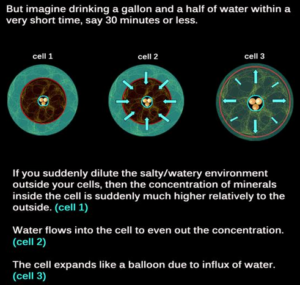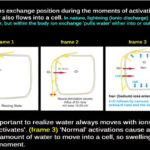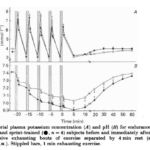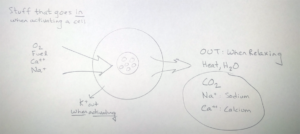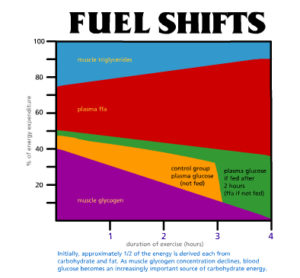Week 16. Visualizing Inflammation and The Energy Depleted State of Cells
The Overused, Fatigued, Swollen, Estrogenic State
Inflammation, ‘bad’ fats, physical training/stress, energy depletion, cell activation, relaxation, cell recovery, and finer points of nutrition may all be understood in context of what ruins or enhances:
Fuel + O2 –> CO2 + H2O + Heat
This final lecture illustrates a more complete and concrete picture of what exactly an ‘energy depleted’ or inflamed cell is – in terms relative to how water, heat, and carbon dioxide are produced.
I want to show you in particular how calcium, excessive exercise/stress, and PUFA’s (polyunsaturated fatty acids) ruin metabolism or energy production by over activating cells and why sodium enhances metabolism.
We’ll begin by looking at why ‘high’ salt intake (sodium) caused Russian cosmonauts to lose weight and NOT retain water despite the fact their caloric intake remained equivalent to a previous experiment eating a lower sodium diet.
The scientists conducting the cosmonaut experiment were ‘stunned’ by the results because it contradicted the ‘science’ in their heads; it all appeared as something novel or new. (google the key words: Russian, cosmonaut, salt)
Ironically, there is nothing new or stunning revealed from the experiment, nor has the science ever supported significant health benefits for a low sodium diet. Ray Peat has detailed the mechanisms involving salt and physiology – and Gary Taubes has published articles presenting the science on salt and health.
I present links and excerpts to Peat’s articles later in this lecture; Taube’s material is just below for your own reading.
- Why Everything We Know About Salt May Be Wrong,
- Salt, We Misjudged You: We Only Think We Know the Truth About Salt
If these scientists knew the evidence of the science as opposed to the dogma in their heads, the heresy they imagine was presented to them would instead have been old news and a ho-hum event. They just found out how it works a little later in life, which contradicted the wrong information they had for years believed in.
It’s never too late to get things right, but it is best to get it right the first time.
I. Sodium’s Effect on Thirst, Metabolism and Weight Loss:
I want to show you why higher salt intake caused the cosmonauts to lose weight and lose more urine.
First, let’s see what exactly happened to the cosmonauts, excerpted from the article: Why Everything we Know About Salt May be Wrong.
When the crew ate more salt, they excreted more salt; the amount of sodium in their blood remained constant, and their urine volume increased. Instead of drinking more, the crew were drinking less in the long run when getting more salt.
So where was the excreted water coming from? “There was only one way to explain this phenomenon,” Dr. Titze said. “The body most likely had generated or produced water when salt intake was high.”
Another puzzle: The crew complained that they were always hungry on the high-salt diet. Dr. Titze assured them that they were getting exactly enough food to maintain their weights, and were eating the same amount on the lower-salt diets, when hunger did not seem to be problem.
Fuel + O2 –> CO2 + H2O + heat.
- Water is one of the products of aerobic metabolism. The increased urine volume came from the water produced endogenously (within the body). Sodium alone caused all this to happen.
- Heat is another product of combustion of fuel. Thus, the higher salt diet also results in weight loss – a greater portion of the cosmonaut’s calories were wasted as heat, less stored as mass.
When this experiment was repeated on mice the article goes on to say:
“The increased levels of glucocorticoid hormones broke down fat and muscle in their own bodies. This freed up water for the body to use.” But that process requires energy, Dr. Titze also found, which is why the mice ate 25 percent more food on a high-salt diet.
Note, it seems Dr. Titze infers the mice did not lose weight or gain even though they increased their caloric intake 25% as a result of having the choice to eat extra food. In contrast, the cosmonauts were on rationed food, so did not have the choice to eat more.
Ray Peat has written on the fact mice prefer to drink salty water if they are place in cold water for awhile. A mouse, like a human, would want to warm up and increase metabolic rate, which is stimulated by salt (sodium) intake. Hot chicken soup in the winter, salted to taste sounds good, does it not?
Given the choice to eat more food at will, the average American eating a salt-laden SAD (Standard American Diet) is likely to overeat, thus nullifying the weight loss that would occur if they kept calories the same like the cosmonauts did.
Ingesting salt amplifies metabolism, which amplifies hunger. People who have plentiful food available then continue stimulating hunger by eating more salty foods this amplifying the entire process by eating a SAD. Keep in mind, I’m describing a caloric increase that exceeds the increased metabolic rate due to sodium, which still results in a net weight increase.
All this is exacerbated by drinking less water, remaining sedentary, and relying on your body to produce water, which then is peed out. Dehydrated cells is the result and norm for many people.
Thus, it is wise to be conscious that you must drink a certain amount of water – not based on thirst – but based on need. People, cosmonauts included, are not as thirsty eating a high salt diet; they drink less water. Enforced, conscious water intake would be a good idea, as practiced by U.S. Air Force Pilots.
At any rate, despite drinking less water people excrete more water/urine when eating ‘salt to taste’ or very high salt diets. Dehydration of cells and a mild stress state of cells is the result… indicated by the increased glucocorticoids – as explained in article:
The animals were getting water — but not by drinking it. The increased levels of glucocorticoid hormones broke down fat and muscle in their own bodies. This freed up water for the body to use.
Thus, I advise drinking a regimen of water so you are conscious of the volume you drink.
ALL the details above were known already, as described by Ray Peat: Salt, Energy, Metabolic Rate, Longevity
“Protein, salt, thyroid, and progesterone happen to be thermogenic, increasing heat production and stabilizing body temperature at a higher level. Prolactin and estrogen lower the temperature set-point.”
“The downward shift of temperature and energy metabolism in toxemia or salt deprivation tends to slow the use of oxygen, increasing the glycolytic use of sugar, and contributing to the formation of lactic acid, rather than carbon dioxide. In preeclampsia, serum lactate is increased, even while free fatty acids are interfering with the use of glucose.”
“One way of looking at those facts is to see that a lack of sodium slows metabolism, lowers carbon dioxide production, and creates inflammation, stress and degeneration. Rephrasing it, sodium stimulates energy metabolism, increases carbon dioxide production, and protects against inflammation and other maladaptive stress reactions.”
… “it isn’t common to see the information applied to other problems, such as aging and the stress-related degenerative diseases.”
“Many young women periodically crave salt and sugar, especially around ovulation and premenstrually, when estrogen is high. Physiologically, this is similar to the food cravings of pregnancy. Premenstrual water retention is a common problem, and physicians commonly offer the same advice to cycling women that was offered as a standard treatment for pregnant women–the avoidance of salt, sometimes with a diuretic. But when women premenstrually increase their salt intake according to their craving, the water retention can be prevented.”
The previous section showed how a mineral can enhance metabolism.
Next I’ll show how another mineral – calcium – can reduce metabolism and inflame a cell by ‘over activating’ it.
II. Calcium triggers muscle contractions, but inflames a cell by over activating it as you overuse or overtrain it.
The purpose of this section is to show:
- Exactly what inflammation is to a cell – visually – but specifically how calcium in a cell relates to a swollen and energy depleted state of a cell
- Why vigorous metabolism (production of CO2) is vital for removal of calcium and sodium out of a cell
Before illustrating this, recall we discussed these things from earlier lessons:
-
Calcium triggers muscle contractions. Greater neural recruitment is greater activation of muscle fibers, which produces a stronger contraction or more tension, all which is determined by greater release of calcium.
-
When you are alive, calcium is reuptaken or removed from the cell when you relax the muscle. When you die, calcium ‘leaks out’ of the sarcoplasmic reticulum into a muscle cell, which makes it contract in rigor mortis.
-
Feeling soreness in a muscle is a slight form of rigor mortis. Soreness is partly due to calcium staying leaked out, which also keeps the muscle very slightly contracted. A bit more water is also kept in muscle cell at this time.
When you intensely activate a cell a small amount of water moves into the cell and potassium moves out, as shown:
click an image to open gallery
Now, if ‘normal’ activation of a cell makes water and calcium move into it, then imagine what chronic overactivation, repeated stress, or excessive physical training does to a cell.
That’s next, explained in context of ruining metabolism by hindering the same ‘ol formula:
Fuel + O2 –> CO2 + H2O + Heat.
The role of carbon dioxide for removing calcium (and sodium) from a cell, which relaxes it.
First explained by Ray Peat below then illustrated afterwards by me.
“When too much calcium enters a cell it activates many enzymes, prevents muscle and nerve cells from relaxing, and ultimately kills the cell. The constant formation of acidic carbon dioxide in the cell allows the cell to remove calcium, along with the small amount of sodium which is constantly entering the cell.
When there is adequate sodium in the extracellular fluid, the continuous inward movement of sodium ions into the resting cell activates an enzyme, sodium-potassium ATPase, causing ATP to break down into ADP and phosphate, which stimulates the consumption of fuel and oxygen to maintain an adequate level of ATP.
Increasing the concentration of sodium increases the energy consumption and carbon dioxide production of the cell.”
Notice he said, adequate sodium is needed outside the cell to maintain ATP converting to ADP, which stimulates:
Fuel + O2 –> CO2 + H2O + Heat
This explains why sodium sped up metabolism, in a nutshell at the cell level, for the cosmonauts. It also explains why maintaining strong resting O2 consumption at 1 MET is important.
Strong resting aerobic metabolism produces CO2. In turn, CO2 aids removal of Na and Ca, which relaxes the cell.
You want to maintain flow of cell stuff – in and out – as best as possible, and keep stuff where it belongs as it relates to the cell in its ‘regenerated, recovered, strongly charged, polarized’ state.
Visualize this whole process:
SUMMARY:
-
Calcium staying in a muscle is ‘bad’. Your cells always work to remove calcium – which is easy at rest – but more difficult after shocking them from very hard workouts or excessive endurance training.
-
Hence, a ‘recovered cell’ (blue/green state seen by sensitives) is a fresh cell with minimal calcium in it.
-
Sore muscles are ‘leaky’ unrecovered, inflamed muscles where a small amount of calcium and other ‘junk’ inflammatory markers remain, until recovered fully.
-
A very sore muscle is inflamed, swollen, and energy depleted (in the orange/red state seen by sensitives)
-
When you are young you are more resilient to shocks and stress; you recover faster – your cells return quicker to a fresher state.
-
When you are older you don’t necessarily lose strength; you can still recruit a great magnitude of muscle fibers, shock the muscle to produce maximum tension close to the amount when you were younger. Imagine the strength of dementia patients who are still very big men, though old; they break peoples’ necks quite easily. Think Verne Gagne.
-
But when you are older, your cells lose resilience to recover back to their fresh state; it takes longer to recover and remove junk, waste, and inflammatory cell stuffs.
III. Visualizing PUFA Inflaming a Cell: Prolonged stress of exercise floods blood with free fatty acids (FFA’s). 20th century diet trends placed more PUFA into peoples’ cells. Severe stress (trauma, sepsis) liberates FFA’s.
Lastly, I show how excessive exercise/stress, and PUFA’s (polyunsaturated fatty acids) ruin metabolism or energy production. First, let’s see how and when the body releases more Free fatty Acids into the bloodstream, most of which may be PUFA’s – dependent on your diet and age.
Keep in mind, both ways shown below involve the release of fatty acids from the fat or lipid stores of your body.
First way. Prolonged exercise results in a required dependency of fatty acids released into the blood for fuel as glycogen, glucose, and fat stored in muscles decline
Second way. Severe stress, sepsis, trauma, and fast/severe weight loss (especially from an obese person) releases an abundance of free fatty acids into the blood.
These types of fatty acids will tend to be NOT saturated fatty acids – instead they tend to be PUFA’s for the following reasons:
If you eat a lot of omega 6 fatty acids, you store these in your fat AND in your cell membranes. Recall or see 20th Century Dietary Changes)
Under stress, the body selectively chooses the fatty acids because their tails are basically ‘poking out’ of the fat stores, which allows for easier and earlier release under stress. They still get oxidized, but only along their saturated sections. Beta-oxdidation doesn’t progress past the double bond, which results in toxic fragments remaining in your body.
Age. Young people store more saturated fatty acids. Older people store more PUFA. This is why restricting PUFA’s – especially C18:2, Linoleic Acid is wise.
Rather than detailing this subject, listed below are the essential reasons why PUFA’s ruin metabolism or energy production. For details read Ray Peat’s Fats, Functions and Malfunctions
1. When PUFA’s become part of a cell membrane they increase a cell’s permeability; they make it ‘more leaky’.
2. More H2O moves into the cell; it swells. This is inflammation. This is the cell in a depleted energy state, which is measured by:
Reduced Fuel + O2 –> CO2 + H2O + Heat
Additionally, the cell is now less stable in the sense how ‘drying oils’ or PUFA’s and oils such as flax-seed oil (aka linseed oil) are used as varnish because they easily combine with oxygen.
When made this way, your cells are prone to free radical damage, less resilient to stress, and exist in a depleted energy state.
Estrogen also leads to energetic depletion. You now have an idea of how it works from everything discussed above. Read Peat’s article to make the connections.
Estrogen and brain aging in men and women: Depression, energy, stress
Next, here’s a real life example of how switching a diet with ‘more’ saturated fatty acids combined with a reduce carb intake results in weight loss and a significant reduction of red, irritated, inflamed skin
Hi Ed,
I’m doing really well. The eczema only seems to come back when I use the wrong massage cream for a couple massages or I don’t eat like I normally do which includes lots of saturated fats and the 1:1 carbs to proteins ratio that you taught us.
The red patch/eczema use to cover the entire back of my right hand and then there were also a couple smaller patches on my left hand (dime sized). Now that I’ve added lots of saturated fats into my diet if I get a flare up it’s generally only a little spot between my index finger and thumb maybe the size of a dime.
I’ve also continued the 1:1 carbs to proteins food ratio that you taught us and lost 30 lbs in the first 6 months and have continued to keep it off by continuing to eat by the 1:1 carbs to proteins ratio. I weighted 170 lbs when I began your class and was 150 lbs by the time the class ended and lost another 10lbs in the 2 months after class. Now I’m just maintaining at 140 lbs.
Feel free to share so that other people can start feeling better too!
Hope all is well with you,
Janelle Debold
SUMMARY:
Fuel + O2 –> CO2 + H2O + Heat: is aerobic metabolism.
Enhanced by: Salt. (Sodium) CO2 itself
Ruined by: Calcium. PUFA. Estrogen. Overuse
Ruining or depressing the oxidative machinery is equivalent to an energy depleted state. ‘Tired’ or energetically deprived cells are worn out cells, which swell with water.
From week 15, last week’s lecture: Ever hear of an enlarged heart? Energetic depletion explains why a person with heart failure has a swollen, weakened heart and people with overuse injuries suffer from inflammation.
Overtraining tires out your cells, like an engine worked too hard.
See this Ray Peat article (Water: swelling, tension, pain, fatigue, aging) and my illustrated piece on the Death of Jennifer Strange and electrophysiology.
Nowhere to Run:
or Showing you the Bodies
Refinements, Higher Thinking, and Talking Points
1. “Peak fitness” is not peak performance
- Eking out gains for a competitive edge comes at the expense of health.
2. Mechanisms of overuse and energy depletion: Energy Starvation Model
- “See the spirit of the sickness before it takes shape”
Finding May Solve Riddle of Fatigue in Muscles
The Failing Heart An Engine Out of Fuel
Visualizing Inflammation and The Energy Depleted State of Cells:
– The Overused, Fatigued, Swollen, Estrogenic State
– Show slides from folder Class: Week 16
Ray Peat: Regeneration and degeneration:
Types of inflammation change with aging
“One way of looking at aging is that it’s a failure of regeneration or healing, related to changes in the nature of inflammation.
In childhood, wounds heal quickly, and inflammation is quickly resolved; in extreme old age, or during extreme stress or starvation, wound healing is much slower, and the nature of the inflammation and wound closure is different. In the fetus, healing can be regenerative and scarless, for example allowing a cleft palate to be surgically corrected without scars (Weinzweig, et al., 2002).
Fifty years ago, inflammation was seen as a necessary part of the healing process, but now it is recognized as a cause of heart disease, diabetes, cancer, and aging itself. During the development of the organism, the nature of healing changes, as the nature of inflammation changes. Early in life, healing is regenerative or restorative, and there is little inflammation. In adulthood as the amount of inflammation increases, healing fails to completely restore lost structures and functions, resulting in scarring, the replacement of functional tissue with fibrous tissue. Identifiable changes in the nature of inflammation under different conditions can explain some of these losses of healing capacity. Factors that limit inflammation and fibrosis, while permitting tissue remodeling, could facilitate regeneration and retard aging.”
3. TIMELINE of VIDEO, Run for Your Life:
- 3:33 “Arteries Harder then his bones” “That can’t be good”
Show striking heart pic
- 4:15 “Not worried about about this” (Not wooried about dropping in the race)
It’s about the worry of dropping later – at ANY time. By definition, the progress toward a myocardial infarction is accumulative – the process of coronary calcium building up over time until the ‘event’ occurs.
Show you the bodies – based on understanding a heart attack – an MI.
A consensus statement was published to give a universal definition of the term myocardial infarction. The authors stated that MI should be used when there is evidence of myocardial necrosis in a clinical setting consistent with MI. Myocardial infarction was then classified by the clinical scenario into various subtypes.
Type 1 is a spontaneous MI related to ischemia from a primary coronary event (e.g., plaque rupture, thrombotic occlusion).
Type 2 is secondary to ischemia from a supply-and-demand mismatch.
Type 3 is an MI resulting in sudden cardiac death. Type 4a is an MI associated with percutaneous coronary intervention, and 4b is associated with in-stent thrombosis. Type 5 is an MI associated with coronary artery bypass surgery.3
- 5:09 Vigorous/Moderate ill defined. REFINE: >LAT vs <LAT
Vigorous running is sprinting.
- 6:30 Dose Makes Poison: Exercise Mode – Speed of Running (MIXES MODES)
- 6:56 – 7:09 Bullet Proof (in terms of outcomes)
PEAK FITNESS not equal to PERFORMANCE vis-a-vis LIFE EXPECTANCY
- 8:00 – 8:25 Cardiac Output – Explain
Not different between athletes and sedentary people. Prevent the bottom from dropping out:
BREAKING WAHLS
Visualizing Cardiac Output and Blood Flow Physics : Week 14
Stroke Volume: From 60ml to 100ml ……. OVERSTRETCHING
KUDOS to O’Keefe
- Heart is “Meant to do this”
- 3 mins, intermittent, <60 min sustained
Below LAT
- 8:26 – 8:42 Adrenalin & Catecholamines
FORCE A WORN OUT, ENERGY DEPELTED HEART TO CONTRACT
BREAK HERE
Energy Model: what O’keefe should know/explain
1. Ca++ leaks out
2. Cells swell over time as calcification occurrs concomitantly
3. Soley to overuse of engine
4. On Tropinin
The two regulatory proteins troponin and tropomysium, which are also part of the thin filament, are involved in turning muscle contraction “on or off [1].”
When a muscle is relaxed, tropomysium blocks the myosin-binding sites on the actin proteins so the myosin heads cannot attach, and therefore the muscle cannot contract. Troponin holds the tropomysium proteins in place.
When calcium enters the cytoplasm of the muscle fiber, it can bind to a troponin molecule, which changes the troponin molecule’s shape and “pulls” the tropomysium away from the myosin-binding site on each actin molecule [2]. When calcium is no longer present, the troponin molecule reconfirms to its original shape and the tropomysium again blocks the binding site.
II. Calcium triggers muscle contractions, but inflames a cell by over activating it as you overuse or overtrain it. Week 16: Visualizing Inflammation
- 8:42 Troponin & Calcium “Overwhelming heart capacity” “Heart muscle has died”
ACUTE INJURY to cell…. NOT the arteries. Each is different, but may happen concomitantly ar different rates.
“Normally open up”… the artery. As in a Type 2 MI.
- 9:50 Plaque graphic
Heart Risk? Marathoners Have Increased Artery Plaque
- 10:28 A-Fib Greg Carroll and Home Depot Guy
- Not ‘dropping dead during’ is not a valid defense
- Enlarged, thickened heart = SWOLLEN, ENERGY DEPLETED HEART
- 12:15 – 13:48 GRAPHS
DISTANCE / SPEED / FREQUENCY
- 14:00 Copenhagen Study
slow to avg pace
1 – 2.5 hrs per week
2 – 3 miles per bout
Isn’t jogging already moderate?
What ELSE is vigorous (besides running)
- 14:31 Heat exhaustion “Other half” of all her other races? (ruins gut)
- 15:11 “Exercise Pattern”?
- Mice – Wrong implication. They recovered from an acute situation NOT a chronic, accumulative buildup.
- 16:09 Curiosity… O’keefe never mentions whether he had a CT scan, but expresses, “I can feel my hear relax… and healing, and getting better”. (Better from a condition he’s not mentioning?)
- 17:30 Those who do want to hear the message. (Understanding Reality quote of Thomas Cleary’s Intro regarding the conditioned mind)
“One feature of the discriminating mind (conditioning) is that it cognizes multiplicity; without the balancing factor of direct perception of organic unity, it is prone to fragmentary awareness and bias. Furthermore, as the patterns according to which the discriminating mind organizes and rationalizes its activities are associated with and influenced by social and cultural identity, they tend to become intimately bound up with emotion, which then increases the tendency to narrowness with prejudice.
As is the case when speaking of the human mentality in general, Complete Taoist Reality teaching often appear extremely negative in their attitudes toward the discriminating mind; (Ed’s reminder….conditioning, status quo, etc) – it is explained that this is because such teachings are addressed to those in whom the discriminating mind has through long use developed into a jealous tyrant which seeks to exclude or discount knowledge not within its range.”
Other readings and references
Acute Myocarial Infarction: definition and etiology
Mortality From Coronary Heart Disease and Acute Myocardial Infarction — United States, 1998

